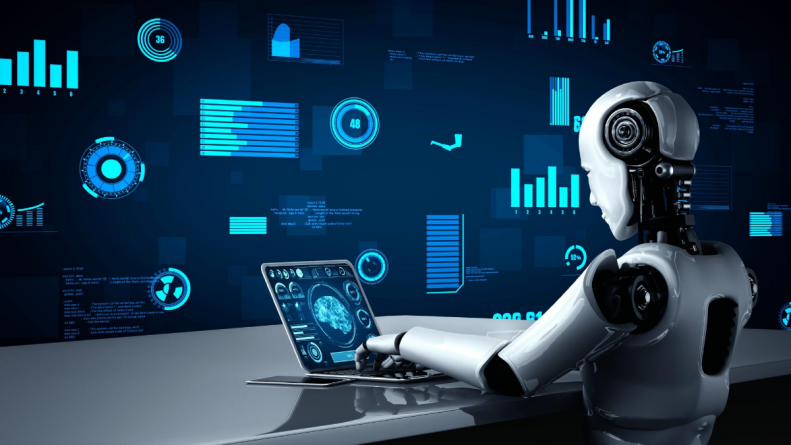-
UNION INTERIM BUDGET 2024-25 -
-
Are cryptocurrencies the future of the digital world economy -
-
Breaking Waves, Breaking News: Lakshadweep’s Recent Developments Explored -
-
The Impact of the Digital Economy on Business and Society -
-
Augmented Marketing: A Comprehensive Guide -
-
How To Strengthen Your Email Marketing Using AI -
-
How Artificial Intelligence and Digitization Are Transforming Our Lives -
-
What Data Science Tools do the Experts Recommend? -
-
Robotic Process Automation Will Transform Your Business? Check Here! -
-
Edge Computing: How it is Reshaping Cloud Infrastructure -
What is an RPA-Automation a Big Game Changer?
Remember the days when you watched Rajnikant’s movie Robot for the first time? The air of the cine hall then filled with amazement and awe. Hardly could we foresee the reels turning into reality. The 21st century is a transformational age, coming with endless technological advancements. Applied science is automating monotonous, duplicating, and mundane tasks. Day after day, our jobs are becoming effortless, with better emphasis on strategy and planning. Robotic process automation, aka RPA Automation, is a software technology seeking to digitize our business functions. As per a study, the adoption rates have risen from 12% in 2019 to 20% in 2021. RPA process has prominence in almost all industries, including human resources, supply chains, finance and accounting, call center operations, and payroll jobs. Let’s understand its integral role in transforming our lifestyles and making our lives smooth and perfect!
What is an RPA Process?
RPA process stands for Robotic Process Automation, which is a software technology in the form of robots imitating human interactions and automating a substantial volume of repetitive tasks.
It is like a virtual assistant helping you in the best possible manner to relax your work and streamline your life.
RPA uses the programming languages such as Visual Basic as well as C# to create software or ‘bots’ called digital workforce for implementing the automation of different business functions.
Simply it engages software robots or ‘bots’ to do the periodic business chores.
Relationship Between RPA and AI
If you are a newbie, then RPA, AI, and ML might sound alike basis their logic-building ability.
But there is a subtle contrast between the terminologies.
1- RPA works in confluence with people to automate repetitious tasks and digitize business operations, while AI aims at superseding human force through digitizing end-to-end processes.
2- RPA relies on structured inputs and predefined logic and AI is proficient in building logic autonomously and can operate independently on unstructured data.
Above all, RPA helps to make your tasks effortless, whereas AI assists you in substituting you.
What is an RPA Developer?
Every science enthusiast, while pondering and reviewing the career paths on the internet, must have come across a profession-RPA developer. But contemplating about its roles and responsibilities? Well undoubtedly, it is quite a contemporary role, with its global inception in the early 2000s. As the term developer suggests, this job profile involves creating and building software and other digital products.
But the role of the RPA developer is not restricted or confined to only writing codes. It is meant for more roles and responsibilities. Its general function is the incorporation of software development, business analysis, and project management. Let’s briefly understand its roles as well as the positions. The following are the multiple stages:
Phase 1: Business Analysis
It involves the understanding of the business case and the identification of the risk and issues. This role implicates revealing the different business functions and identifying the pain areas of the end users. Business requirement gathering is typically accomplished through interviewing the employees and introspecting about their necessities.
The RPA industry is full-fledged and established, with thousands of software packages already created.
The developer will try to check whether the existing solutions can suit the problem case.
After learning the logic and interpreting the case, the concerned developer will document a well-defined manuscript stating the concurring steps to develop the solution.
Phase 2:Software Development
In this position, an RPA developer will create an ecosystem, station the robot, surveil its performance, and amalgamate it with corporate technology. After coding, the testing and troubleshooting phases come into action. User acceptance testing is a chief role before, the actual validation of the finally released products.
Applications of RPA
RPA is earning its name day after day and gearing fame across the world. Over a while, especially post-COVID-19, digital transformations have become an area of key focus for industries.
According to the CEO of Microsoft, he set a global pursuit of 2 years of digital transformations in 2 months.
As per a study, around 81% of companies globally, varying from mid-scale to large-scale have started approaching RPA automation to attain faster operations and to achieve a cost-saving model.
As per insights shared at Deloitte, 16% of companies are intending to switch their business operations to automatic modes within three years.
Finally, today almost all industries have commenced, adopting digitization to save their high recurring costs ensuring financial optimization.
Seven role areas below are most likely to embrace robotic automation.
1- Customer Support
It is the most impactful area for automation. The way of interacting with customers is going to be 360 degrees transformed.
With RPA automation, the ticket resolution process will be swifter and hassle-free. There will be no necessity, for manually scanning the information of customers, or validating their details.
In the service industry, companies are receiving complaints and escalations every day, in abundance. Automatic categorization replaced manual sorting. Thanks to RPA, for unraveling the clutter and making the task simpler.
Additionally, RPA has sorted too much human intervention, making the process of resolution easier and quicker, enhancing the customer experience.
2- Data Analytics
Data is fuel. It is the pillar of any business function, assisting in making critical decisions.
Quality data is a backbone, however, any degradation in the data standard will impact the decision-making, resulting in the wrong conclusions, and hampering managerial performance.
Moreover, Data provides opportunities and unveils the status of the business performance.
Though there are numerous tools available to analyze and study the data, dealing with large volume sets can be tiresome and overwrought. With a process, interpret the information and receive the insights within seconds.
3- Payroll
Too much human intervention consciousnesses many HR employees. The amount of time taken and the portion of stress colonizing the minds is cumbersome.
Not this elevates the tendency, of making human errors, but also harshly impacts productivity.
With automated workflows, duplicating tasks are digitized as well as scrap, such as data transfer, payslip generation, etc.































